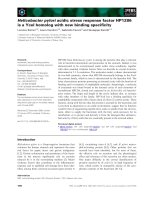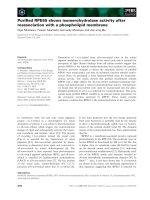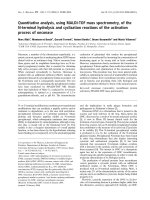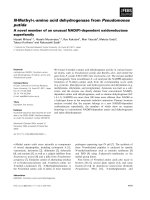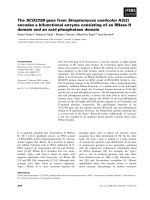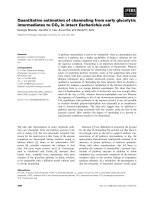Báo cáo khoa hoc:" Quantitative competitive reverse transcription polymerase chain reaction is not a useful method for quantification of CD4 and CD8 cell status during HIV infection" pptx
Bạn đang xem bản rút gọn của tài liệu. Xem và tải ngay bản đầy đủ của tài liệu tại đây (221.18 KB, 4 trang )
BioMed Central
Page 1 of 4
(page number not for citation purposes)
Journal of Negative Results in
BioMedicine
Open Access
Brief Report
Quantitative competitive reverse transcription polymerase chain
reaction is not a useful method for quantification of CD4 and CD8
cell status during HIV infection
Heather B Jaspan
1
, H Richard Gaumer
2
and Robert F Garry*
1,3
Address:
1
Interdisciplinary Program in Molecular and Cellular Biology Tulane University School of Medicine New Orleans LA, 70112, USA,
2
Department of Pathology Louisiana State University Medical Center New Orleans LA, 70112, USA and
3
Department of Microbiology and
Immunology Tulane University School of Medicine New Orleans LA, 70112, USA
Email: Heather B Jaspan - ; H Richard Gaumer - ; Robert F Garry* -
* Corresponding author
Abstract
Background: A polymerase chain reaction (PCR)-based method for quantitating CD4 and CD8
mRNA could provide a means of assessing immune status of AIDS patients and other
immunologically compromised persons without requiring large blood draws, and could be
exquisitely sensitive. Such a method would also be useful in assessing the immune status of patients
retrospectively.
Results: Quantitative competitive reverse transcription PCR (QC-RT-PCR) assays were
developed for measurement of CD4 and CD8 mRNA. Samples were obtained from HIV-positive
and negative patients whose CD4 and CD8 counts had been determined via Flow Cytometry. The
quantity of CD4 (n = 13) and CD8 (n = 28) mRNA standardized according to GAPDH mRNA
quantities, all determined by QC-RT-PCR, were compared to cell number as determined by flow
cytometry. There was no correlation between CD4 and CD8 cell counts and mRNA levels of CD4
and CD8 as determined by QC-RT-PCR. There is no correlation between CD4 and CD8 mRNA
levels and the number of cells expressing these proteins on their surface.
Conclusion: QC-RT-PCR, and related methodologies are not useful substitutes for assessment of
CD4 and CD8 cell numbers in HIV-infected persons.
Background
The progression of HIV disease involves various stages
characterized by changes in lymphocyte subsets and viral
load. After initial infection, an acute viremic stage occurs,
which is accompanied by a rapid decline in the number of
CD4+ T lymphocytes and a slow increase in CD8 counts.
During the clinical latency phase, CD4 counts gradually
decline, and HIV load is lower than during the acute stage,
although virus is still present [1]. Finally, the late stage of
HIV disease is reached, where CD4+ T-cells fall severely,
and the number of viral particles surge. In the case of the
HIV infected patient, emphasis is placed on CD4 counts
because when the number of CD4+ T-cells falls below a
critical level, prophylaxis against opportunistic infection
is initiated.
Flow cytometry is not useful for samples that have been
frozen or stored, therefore retrospective studies involving
HIV-infected patients' samples are unable to view the data
in the light of information regarding the immune status at
Published: 12 March 2003
Journal of Negative Results in BioMedicine 2003, 2:2
Received: 25 August 2002
Accepted: 12 March 2003
This article is available from: />© 2003 Jaspan et al; licensee BioMed Central Ltd. This is an Open Access article: verbatim copying and redistribution of this article are permitted in all
media for any purpose, provided this notice is preserved along with the article's original URL.
Journal of Negative Results in BioMedicine 2003, 2 />Page 2 of 4
(page number not for citation purposes)
the time the samples were frozen. We also perceived that
studies of HIV-1 status, particularly in infants, could be fa-
cilitated by a technique using smaller amounts of blood,
such as that from a heelstick or finger-prick [2]. Quantita-
tive methods for reverse transcriptase polymerase chain
reaction (RT-PCR) are rapidly surpassing all other meth-
ods of quantifying mRNA levels. We therefore set out to
develop an RT-PCR based method to quantitate CD4 and
CD8 mRNA in the hopes that this could be used to predict
cell counts. Although it has long been known that HIV-1
down-regulates CD4 cell surface expression [3,4], the loss
of CD4 is not complete and the HIV-infection does not re-
duce CD4 mRNA levels [5]. Thus, a method based on
quantitating CD4 and CD8 mRNA could provide a means
of assessing immune status without requiring repetitive
and large blood draws, and could be exquisitely sensitive.
This method may also be useful in assessing the immune
status of patients retrospectively from archived or frozen
samples. QC-RT-PCR, and related methodologies, howev-
er, did not prove useful as substitutes for assessment of
CD4 and CD8 cell numbers in HIV-infected persons.
Results
Samples were acquired from Special Hematology, Louisi-
ana State University Medical Center, after exempt status
was obtained from Tulane Institutional Review Board.
The relationship between CD4 and CD8 cell number by
flow cytometry, and the amount of mRNA as quantitated
by QC-RT-PCR, was determined. Flow cytometry was per-
formed as previously described [6] along with white
blood cell and differential counts, including percent lym-
phocytes, in order to determine numerical values. Intact
mRNA was successfully extracted from as little as 400 µl of
whole blood, comparable amounts to that obtained from
infants via heelstick. This mRNA was used to quantify the
amount of CD4, CD8, as well as GAPDH, mRNA that is
being transcribed in T lymphocytes within the blood. The
corrected quantity of CD4 and CD8 mRNA as determined
by QC-RT-PCR and the corresponding CD4 and CD8
counts of that patient as determined by flow cytometry are
depicted in Table 1. The patients' HIV status, if known, is
also shown. The patients with unknown status all have in-
verted CD4:CD8 cell ratios and are therefore likely to be
HIV infected (the majority of the samples sent for flow cy-
tometry are HIV-positive). The relationship between the
mRNA and cell number for CD4 and CD8 are depicted
(Fig. 1A, 1B). The correlation coefficients are -0.2S and
0.13 respectively.
Discussion
Our results indicate that there is no correlation between
CD4 and CD8 mRNA levels and numbers of cells express-
ing these proteins on their surface. The formation of CD4-
gp160 complexes in intracellular compartments may con-
tribute to cell surface CD4 down-modulation during HIV-
1 structural protein expression [4]. These and other mech-
anisms may explain the lack of correlation between mes-
sage and surface expression in HIV-positive individuals.
HIV infection may also interfere with the translation or
surface expression of CD8, although it is not used as a vi-
ral receptor. Whatever the mechanism, no correlation be-
tween CD4 and CD8 cell counts and mRNA levels of CD4
and CD8 could be determined by QC-RT-PCR. There was
also no correlation between CD4 and CD8 mRNA levels
and the number of cells expressing these proteins on their
surface. Given the magnitude of the variations observed
by QC-RT-PCR it is unlikely that other methods to quan-
titate these mRNAs, e.g. northern blotting or real-time
PCR, would reveal a correlation either.
Conclusions
QC-RT-PCR and related techniques such as real-time PCR
are not useful as substitutes for assessment of CD4 and
CD8 cell status in HIV-infection by flow cytometry.
Methods
QC-RT-PCR
The strategy for development of competitor templates for
quantitative-competitive RT-PCR (QC-RT-PCR) was simi-
lar to that of Lipman and coworkers [7]. Oligonucleotide
primers (Clontech, Palo Alto, CA) were chosen that span
introns of CD4 and CD8 genes in order to avoid amplifi-
cation of cellular DNA contaminating RNA preparations.
Products are generated from cDNA and deletional mu-
tants are constructed by restriction endonuclease diges-
tion and religation. The deletional mutants were then
subcloned using the TA cloning vector pCR2.1 (Invitro-
gen, Carlsbad, CA), and sequenced for confirmation. The
method used to generate a competitor for CD8 was slight-
ly different than previously reported methods. The wild
type PCR product was inserted into the TA cloning vector
before digesting with BbsI, an enzyme with no recogni-
tion sites inside the vector and only one site in the insert.
The linearized plasmid was gel purified, the free ends of
the plasmid were then shortened using Bal31 nuclease.
The ends were filled using the Klenow fragment of DNA
Polymerase, and then religated. The competitor template
for glyceraldehyde phosphate dehydrogenase (GAPDH),
used to control the amount of RNA in each extraction,
have already been constructed by Lipman et al., (1994),
and were kindly provided by Dr. Martha Pavlakis, Harvard
Medical School, Boston, MA. The primer sequences are:
Sense 5'GGTGAAGGTCGGAGTCAACG3', Antisense
5'CAAGTTGTCATGGATGACC3'.
All plasmids were consequently purified and serially dilut-
ed. Known concentrations of the competitor cDNA was
amplified in the same reaction tube as unknown amounts
of sample derived RT-cDNA. This cDNA was obtained as
follows. Total RNA is extracted from 400 µl to 1 ml of
Journal of Negative Results in BioMedicine 2003, 2 />Page 3 of 4
(page number not for citation purposes)
Figure 1
The relationship between cell counts and the quantity of mRNA as determined by QC-RT-PCR. (A) CD4, and
(B) CD8. The HIV status of each sample is depicted. represents HIV positive status, ■ represents HIV negative status, and ▲
reepresents unknown status.
A
0
10
20
30
40
50
60
70
80
0 200 400 600 800 1000
CD4 counts (cells/µl)
CD4 mRNA
B
0
2
4
6
8
10
12
0 500 1000 1500 2000 2500 3000
CD8 counts (cells/µl)
CD8 mRNA
!
Publish with BioMed Central and every
scientist can read your work free of charge
"BioMed Central will be the most significant development for
disseminating the results of biomedical research in our lifetime."
Sir Paul Nurse, Cancer Research UK
Your research papers will be:
available free of charge to the entire biomedical community
peer reviewed and published immediately upon acceptance
cited in PubMed and archived on PubMed Central
yours — you keep the copyright
Submit your manuscript here:
/>BioMedcentral
Journal of Negative Results in BioMedicine 2003, 2 />Page 4 of 4
(page number not for citation purposes)
whole blood using a similar method to Zhang and Yunis
[8]. First strand cDNA is synthesized using oligo dT prim-
ers and Maloney murine leukemia virus reverse tran-
scriptase (Promega, Madison, WI), diluted 1 to 3, then 3
µl is used as template in a 25 µl PCR. The remainder of the
reactions were made up by 5 µl PCR Buffer (Gibco BRL,
Grand Island, NY), 0.25 µg of each primer, 6 mM MgC12
in each CD4 reaction and 4 mM MgC12 for CD8 reac-
tions, 2 mM total dNTP's, and 0.5 U of Taq Polymerase.
For CD4 and CD8 reaction conditions were : 94° for 3
mins, then 33 cycles of 94° for 45 secs, 55° for 45 secs,
and 72° for 2 mins on a Perkin Elmer Thermocycler. 33
cycles was chosen as this was the largest number still with-
in the linear range of the PCR (data not shown). In each
assay we performed at least six different reactions for each
sample using increasing amounts of competitor DNA. The
amounts of sample were quantitated by extrapolating
across at least three reactions in which approximately
equal amounts of sample and competitor products were
produced.
The PCR products are run on a 1.5% agarose gel. Quantity
of sample derived mRNA can be determined when the in-
tensity of its PCR band is equal to that of the competitor's
upon co-amplification. Staining with ethidium bromide
can be quantitative provided that digital imaging is em-
ployed [9]. The standard curve plots the log cDNA/com-
petitor band intensity (as determined by analysis of PICT
files with NIH image) on the x-axis versus the log of incre-
mental dilutions of competitor DNA on the y-axis. Solv-
ing for the antilog of x when y = 0 will give the
concentration of unknown amount of DNA – that of
CD4, CD8 or GAPDH. The success of the RNA extraction
and reverse transcription is determined by quantification
of GAPDH mRNA by QC-RT-PCR. Each value for quantity
of CD4 or CD8 mRNA was standardized according to the
amount of GAPDH mRNA in the sample.
Authors' contributions
Heather Jaspan conceived of the study, performed all the
molecular analyses, and wrote the manuscript. Richard
Gaumer provided patient samples and performed flow cy-
tometry analyses. Robert Garry supervised the study and
contributed to the writing of the mansccript.
Acknowledgements
Supported by NIH Grant Number F30 MH11331 and the Keck Foundation.
References
1. Piatak M Jr, Saag MS, Yang LC, dark SJ, Kappes JC, Luk KC, Hahn BH,
Shaw GM and Lifson JD High levels of HIV-1 in plasma during all
stages of infection determined by competitive PCR. Science
1993, 259(5102):1749-1754
2. McKinney RE Jr and Wilfert CM Lymphocyte subsets in children
younger than 2 years old: normal values in a population at
risk for human immunodeficiency virus infection and diag-
nostic and prognostic application to infected children. Pediatr
Infect Dis J 1992, 11(8):639-644
3. Stevenson M, Zhang XH and Volsky DJ Downregulation of cell
surface molecules during noncytopathic infection of T cells
with human immunodeficiency virus. J Virol 1987, 61(12):3741-
3748
4. Crise B and Rose JK Human immunodeficiency virus type 1
glycoprotein precursor retains a CD4-p56lck complex in the
endoplasmic reticulum. J Virol 1992, 66(4):2296-2301
5. Geleziunas R, Bour S, Boulerice F, Hiscott J and Wainberg MA Dim-
inution of CD4 surface protein but not CD4 messenger RNA
levels in monocytic cells infected by HIV-1. AIDS 1991, 5(1):29-
33
6. Gaumer HR Optimizing the comparison of two and four color
flow cytometric immunophenotyping. Cytometry 1998, Supple-
ment 9:109
7. Lipman ML, Stevens AC and Strom TB Heightened Intragraft
CTL gene expression in acutely rejecting renal allografts. J
Immunol 1994, 152(10):5120-5127
8. Zhang Y and Yunis JJ Improved blood RNA extraction micro-
technique for RT-PCR. Biotechniques 1995, 18(5):788-792
9. Shubsda MF, Goodisman J and Dabrowiak JC Quantitation of
ethidium-stained closed circular DNA in agarose gels. J Bio-
chem Biophys Methods 1997, 34(1):73-79

